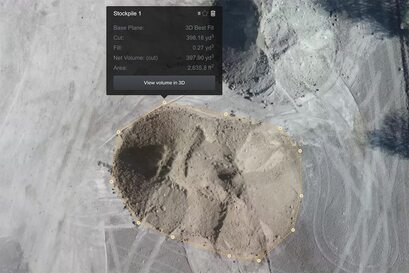
Stockpile Measurement services are used to accurately measure the volume and mass of materials stored in stockpiles, like minerals, aggregates, coal, and other bulk materials. Accurate measurements are crucial for inventory management, stockpile management, and production planning in industries like mining, construction, and logistics.
Process
Stockpile measurement services typically involve the use of various technologies and techniques:
- 3D Laser Scanning
- Drones
- Ground-Based Surveying
- Software
3D laser scanners are used to capture the shape and dimensions of the stockpile. The scanner generates a point cloud, which can create a 3D model of the stockpile. The Stockpile Volume Measurement model can be used to calculate the volume and mass of the material stored in the stockpile accurately.
In Drone Stockpile Measurement, drones equipped with cameras and LiDAR sensors can be used to capture aerial images of the stockpile. These images can be used to create a 3D model of the stockpile which can be used to calculate the volume and mass of the material stored in the stockpile accurately.
Ground-based surveying methods, like total stations or GPS, can be used to measure the height and dimensions of the stockpile. Stockpile Volume Measurement can be used to calculate the volume and mass of the material stored in the stockpile.
Specialized software is used to process the data captured by measurement technologies and calculate the volume and mass of the material stored in the stockpile.
Benefit
Stockpile Measurement services offer many benefits to industries that store bulk materials in stockpiles. They are:
- Accurate inventory management
- Improved stockpile management
- Enhanced production planning
Accurate measurement of the volume and mass of the material stored in the stockpile enables accurate inventory management, reducing the risk of overstocking or stockouts.
Accurate Stockpile Volume Measurement enables better management of the stockpile, improving the efficiency of material handling and reducing the risk of material losses due to overloading or spillage.
Accurate measurements of the material stored in the stockpile can help improve production planning.
Moreover, Drone Stockpile Measurement has several advantages over traditional methods. Drones can cover large areas quickly, reducing the time and cost of measurement. They can also capture data from hard-to-reach or hazardous areas that may be difficult for humans to access.
Application
Stockpile Volume Measurement services have a wide range of applications in various industries that store bulk materials in stockpiles. Some examples:
- Mining
- Construction
- Logistics
- Agriculture
- Waste Management
Drone Stockpile Measurement is used in the mining industry to accurately measure the volume and mass of minerals and ores stored in stockpiles. It helps mining companies manage their inventory, plan production, and optimize material handling processes.
In the construction industry, Stockpile Measurement services are used to measure the volume and mass of materials, such as sand, gravel, and crushed stone, stored in stockpiles.
Stockpile measurement services are used in the logistics industry to measure the volume and mass of goods stored in stockpiles, like containers, pallets, and bags.
In the agriculture industry, Drone Stockpile Measurement services are used to measure the volume and mass of crops stored in stockpiles, like grains, hay, and silage.
Stockpile measurement services are also used in the waste management industry to measure the volume and mass of waste materials stored in stockpiles, like landfill sites.
Overall, Stockpile Measurement services are essential for industries that store bulk materials in stockpiles. Accurate measurements of the volume and mass of the material stored in the stockpile enable better inventory management, stockpile management, and production planning, leading to increased efficiency and profitability.